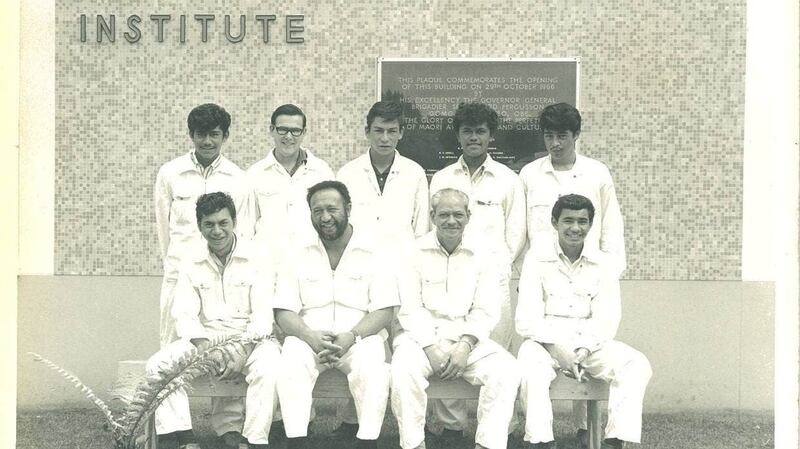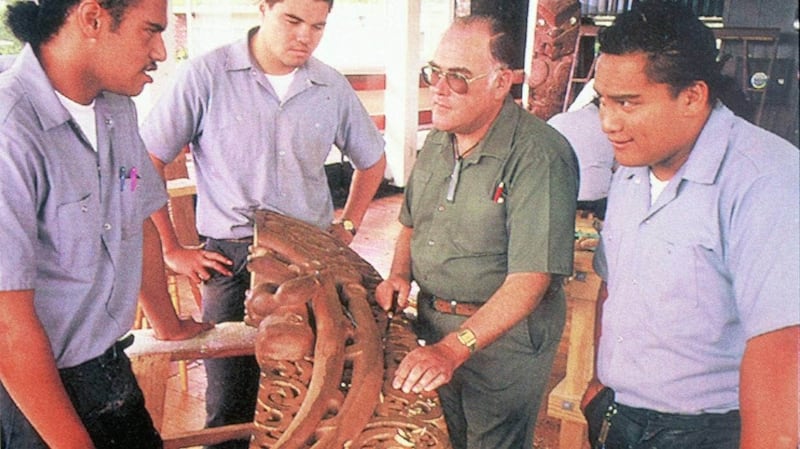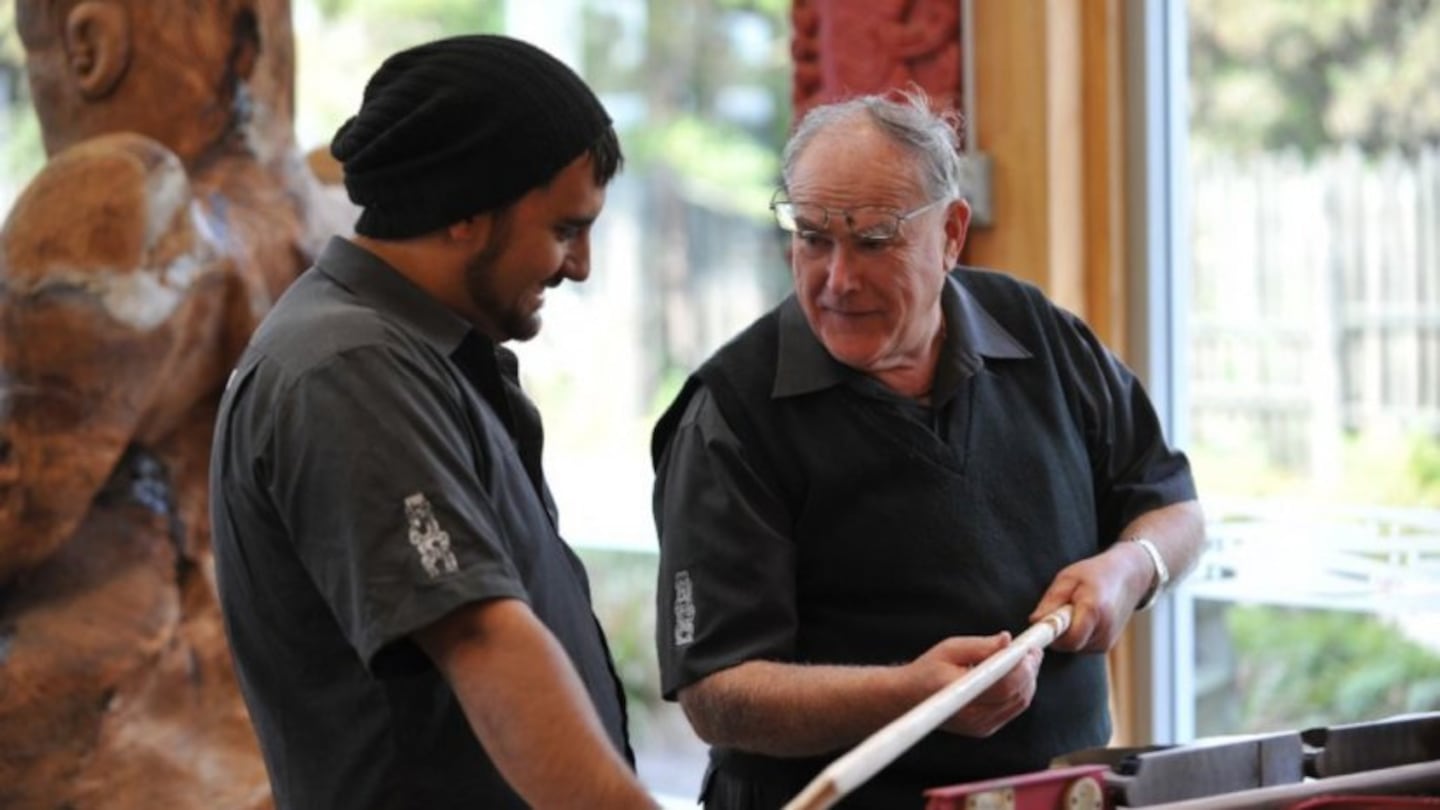Ko te Tohunga Whakairo, ko Clive Fugill ka tohua ki Te Tohu Tāpui
Te tikanga kua mutu kē ngā mahi a te koroua e 74 tau te pakeke nei, i Te Wānanga Toi Māori i Rotorua, ko ia te tohunga whakairo i Te Wānanga Whakairo Rākau i reira.
Heoi inā te mahi whakairo, he wāhanga nui i te oranga o Clive Fugill, he uaua te whakarere noa i ana whao. Kei reira tonu ia e rua rā i te wiki.
“Kia pā noa atu aku ringa, kia whai wā hoki ki te tūtakitaki, ki te mahi tahi me ngā tauira.”
18 ōna tau ka uru atu a Clive ki roto i te ranga tuatahi o Te Kura Whakairo i te tau 1967, i akohia e Hone Taiapa rāua ko Tuti Tukaokao. Engari he mahi uaua tonu te whai tūranga. Kāore te uepū uiui i whakapono he Māori te tangata kiritea, whīrokiroki te hanga, kōwae ngā makawe i te taha, mau mōhiti hoki. Kātahi tōna matua a Alfred ka hora atu i ngā whakapapa o tana tama ki a Ngāti Rangiwewehi, ki a Ngāi Te Rangi, ki a Ngāti Ranginui, ki a Ngāti Raukawa, ka mana.

He tauira taikaha ia, he kaingākau ki te ako, ka piri atu ki a Hone, ā, pau atu he hāora i ia rā i te taha i a Hone ki te ako i te whakairo, kia ngata ai tāna i pohewa ai nōna e tamariki ana.
“Ka mōhio ana a Hone kāore ahau i reira ki te kai noa iho i taku tina, engari i hīkaka ahau ki te whakairo, kātahi ka tīmata ki te whāngai haere i ngā mātauranga ki a au,” tā Clive e mahara nei. “Heoi anō nō te ao tahito a Hone, kotahi tonu te kōrero, me mau i a koe. E kore e hokia te kōrero.”
Ka puta te ihu o Clive—me te tohu tiketike nā Te Kura Whakairo—ka noho a ia ki reira hei kaiwhakairo, hei kaiako, ā, tae atu ki te wā ko ia Te Tumu Whakarae o taua kura mai i ngā tau 1983 ki te 1995.
Nāna i whakahoahoa, i whakanikoniko, i whakarauora i ngā hanganga whakairo Māori puta noa i te motu. Ko Te Mahau, te atamira o Te Matatini me te whakairo Māori nunui i te ao, tētahi hua o āna mahi. Kua kohaina hoki ana taonga whakairo ki ngā ariki, ki te hunga rongonui, ki ngā kaingārahu hoki o te ao whānui.
Ko tana mahi hihiri ki a ia? Ko tōna tipuna whare kei tōna marae, ko Tūtereinga kei Te Puna, i Tauranga. I whakatūwheratia i te tau 1990.
“Ka whai hononga koe ki ētahi mahi; ka whakatōkia ki roto, ko tō manawa, ko tō wairua.”
Mō te mahi whakairo, e ai ki a Clive, he ringa hangarau ia. Me tana kī anō kāore ōna ringaringa me ōna whatingaringa e pai mō te tārai taonga nunui. Nā reira ko te āhuatanga o ana whakairo, he whakanikoniko taonga iti noa, he whakairo whakatarapī.
“He tohu tō tēnā kaiwhakairo, tō tēnā kaiwhakairo,” e ai ki a Clive. “Ki te tirohanga o Uropi, ko ngā ringa toi i mahi mā Chippendale, mā Stradivarius, nā tēnā ringa toi nā tēnā anō tāna ake āhua i hanga i roto i ā rātou mahi. He pērā anō te whakairo. A Te Arawa, he āhua ake anō i ana whakairo, engari e mārama ana te āhua o Ngāti Tarāwhai, o te tohunga whakairo rānei, o Tene Waitere.”

I tēnei rā tonu ka kite ana a Clive i ētahi o ngā mahi whakairo a ana tauira, mōhio tonu atu ana nā wai.
E mahia ana tana pukapuka hōu mō te whakairo, e tō mai ana i ana wheako i ōna tau e rima tekau neke atu hei kaiwhakairo, “nā reira ka mau ko te iti me te rahi o ngā momo mea katoa.” He nui ngā mātanga mātauranga kua tuhi pukapuka mō tēnei kaupapa, heoi anō ko tā Clive he whai pūmau ki te tikanga a Hone Taiapa: Ehara i te mea hei kōrero, engari he mea ka mahia.
Master Carver Clive Fugill is a Companion of the New Zealand Order of Merit.
Officially, the 74-year-old has retired from the NZ Māori Arts and Crafts Institute in Rotorua, where he was a tohunga whakairo at its national wood carving school, Te Wānanga Whakairo Rākau.
But carving has been such a big part of Clive Fugill’s life that it’s hard to put his tools down. So, he still spends 2 days a week there.
“It keeps my hand in and gives me some time to associate with the students.”
Clive was an 18-year-old student of the first intake of the carving school in 1967 taught by Hone Taiapa and Tuti Tukaokao. It took some convincing to get him in there. The interview panel didn’t believe the skinny, white guy with a side part and glasses was Māori. So his dad Alfred pulled out the whakapapa from Ngāti Rangiwewehi, Ngāti Ranginui, Ngāi Te Rangi and Ngāti Raukawa to prove it.
He was an avid student, latchinga on to Hone and spendinga at least an hour a day with Hone to learn more about carving and satisfy a curiosity that had been with him as a kid.
“When Hone realised I wasn’t just there to eat my lunch and wanted to learn more, he opened up a bit and gave me information,” Clive remembers. “But he was pretty ‘old school,’ he told you once and expected you to get it.”
Once he graduated—with the prize for top honours—Clive stayed on and became a carver, tutor, then Tumu Whakarae, the head of the carving school, from 1983 to 1995.
He designed, adorned, and restored structures around the country. This includes Te Mahau, the stage built for Te Matatini and the largest Māori carving in existence. His carvings have also been gifted to royalty, celebrities, and world leaders.
The work which he is most proud of? The wharenui of his marae, Tūtereinga at Te Puna near Tauranga which opened in 1990.
“You have an affinity to some pieces; you are putting your heart and soul into it.”
Clive describes himself as a technician when it comes to carving. His hands and wrists don’t lend themselves to the work needed on big pieces. So detailed work on small items or fine carving is characteristic of his work.
“Every carver has a hallmark,” Clive claims. “From a European perspective, artists who worked for Chippendale or Stradivarius made their own mark in their work. Carving is the same. Te Arawa has a carving style but there are hallmarks of Ngāti Tarāwhai or the carver, Tene Waitere.”
Even today, Clive can identify the work of some of his carving students a mile off.
His next book is on carving, drawing on the experience he’s amassed from more than 50 years as a carver, “so it will have a bit of everything in it.” Plenty of academics have written books on the subject he says, but Clive follows the rule of Hone Taiapa: It’s not a thing you talk about, it’s a thing you do.



